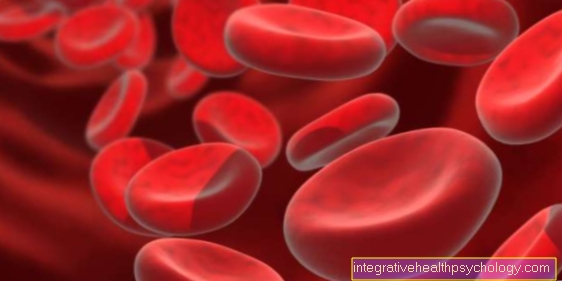Staphylococci
definition
Staphylococci are a type of bacteria that belongs to the group of so-called spherical bacteria. They are around 0.1 micrometers in size and, as spherical bacteria, have no active mobility of their own.
Staphylococci are gram-positive (this is a staining method to further classify bacteria). They are usually found individually or together in the form of grape vines. Their optimum temperature for reproduction is around body temperature and their generation duration, i.e. their cycle of division, is around two hours.
Staphylococci are only facultatively pathogenic. This means that when they colonize wounds, they cause "disease". If they are on the skin or in our intestines through food, they do not cause any disease.

What staphylococci are there?
Staphylococci can be divided into two large groups using a special microbiological test. With the help of this test, the clumping behavior of the bacteria is examined, more precisely whether they produce the enzyme coagulase.
Staphylococcus species that do not do this include, for example, Staphylococcus epidermidis, which can be found on almost all human skin. There is also the Staphylococcus haemolyticus, which is able to destroy erythrocytes, the red blood cells. Staphylococcus lugdunensis is another representative of the coagulase-negative staphylococci. It is also found on people's skin, mainly in the genital area near the anus.
The last known representative of the staphylococci without a coagulase enzyme is the Staphylococcus saprophyticus. It is assumed that it is transmitted to humans in contact with animals, primarily with cattle.
Among the coagulase-positive staphylococci is the well-known main representative of Staphylococcus aureus. This is the potentially most dangerous form of staphylococci, which has since become known as the so-called MRSA form. The MRSA form is a type of Staphylococcus aureus that can no longer be treated with a large number of antibiotics because it is resistant to those drugs. MRSA stands for "Methicillin-resistant Staphylococcus aureus"
Read more on the subject at: Coagulase test
Staphylococcus aureus
The Staphylococcus aureus is the most likely pathogenic germ from the family of the staphylococci. This germ is coagulase-positive.
It owes its nickname aureus - i.e. golden - to its appearance when growing on a Petri dish. Here the colonies form a golden shimmering halo around the individual colonies.
In the case of local infections on the skin, the germ causes the formation of small abscesses or small boils. The pus contained is more of a cheesy consistency, which also distinguishes this germ from other pathogens of the staphylococcal family.
Furthermore, the Staphylococcus aureus is the germ that has achieved dubious notoriety in an antibiotic-resistant variant.
This is the MRSA form - the "Meticillin-resistant Staphylococcus aureus" form. This can no longer be treated with the usual standard antibiotics, but requires special treatment, which usually lasts longer than the treatment of normal Staphylococcus aureus.
If a generalized infection occurs, the germ can secrete a certain toxin, which can lead to multiple organ failure and ultimately death.
Staphylococcus epidermidis
As the name suggests, Staphylococcus epidermidis is a skin germ. It occurs physiologically on the skin of every person and is only dangerous for people in special cases.
In the hospital in particular, however, it can lead to small local irritations and inflammations. If objects piercing the skin are not cleaned properly in this environment, the germs can get into the wound, multiply there and cause a local inflammatory reaction, in the worst case even with pus formation.
In the worst case, bacterial settlements can become detached from this wound and reach the heart with the bloodstream, where they then attack the heart valves and possibly destroy them.
These staphylococci are dangerous
First and foremost, the staphylococci are only considered to be facultative pathogenic. This means that they are not dangerous to come in contact with with unwounded skin.
They only become “dangerous” when they get into a wound.
The Staphylococcus epidermidis is probably the most common, but the Staphylococcus aureus the most dangerous germ that can penetrate.
Infection with the germs is usually not a problem for people with immune health problems. However, if the number of germs that have penetrated is particularly high or if the person has an immunodeficiency, the infections can spread in the body and, in the worst case, lead to fulminant blood poisoning.
These staph infections do exist
Staphylococcal infections can also be subdivided according to the causing staphylococcal species. Staphylococcus aureus, for example, is primarily responsible for the development of open pus blisters (so-called impetigo contagiosa) and abscesses filled with pus. In addition, if the immune situation is poor, inflammation of the heart, lung membrane or meninges can occur.
In addition, in particularly severe cases, Staphylococcus aureus can lead to toxic shock syndrome or scaled skin syndrome. The former is blood poisoning that can lead to multiple organ failure, as the germ produces a toxin that spreads throughout the body. The second is a phenomenon that occurs primarily in young children. The infection ensures that the topmost skin layer of the body is detached over a large area.
Staphylococcus epidermidis, lugdunensis or saprophyticus, on the other hand, do not create such fulminant courses. The epidermal form usually causes local inflammation and, in the worst case, can cause inflammation of the heart muscle. Staphylococcus lugdunensis is also known to affect the heart, while Staphylococcus saprophyticus is common in cystitis.
You can find more about this on our website Staph infection
These symptoms are how I recognize a staph infection
The symptoms of an infection with staphylococci are manifold and usually not exactly definable. In addition, they depend on the type of staphylococcus causing the infection and which organ system is affected.
What all infections have in common, however, is the development of a fever, provided it is an infection that affects the whole body. If only a small local area is affected, this area usually shows reddening and increased sensitivity to pain.
If the infection affects one of the internal organs, as is usually the case with coagulase-negative staphylococci, symptoms of cardiac arrhythmia or loss of performance or a burning sensation when urinating can indicate that the organ concerned is infected with staphylococci.
Staphylococcus aureus, on the other hand, mostly affects the skin, so that the increasing formation of small abscesses or "exposed skin areas" are an indication of a staphylococcal infection. If you have become infected with a resistant type of Staphylococcus aureus, the non-effectiveness of the standard antibiotics can also be an indication of this specific staphylococcal infection.
That's how contagious staphylococci are
Staphylococci belong to the facultative pathogenic germs. This means that they are only able to cause infections with a weakened immune system, open injuries or previous illnesses. So normally they are hardly contagious.
In addition, staphylococci - at least some species - are typical skin germs in humans. So they are always on the skin and humans or various animals serve as a reservoir.
However, staphylococci are characterized by a very high environmental tolerance. So they are difficult to get rid of, which is why they can survive on exposed surfaces for hours or even days and still remain contagious.
However, hardly anyone who has had contact with a person with a staph infection becomes ill. As already mentioned, every person carries a certain subgroup on their own skin, which does not keep them sick again. And besides, transmission of staphylococci does not mean an infection by a long way; even if it is a different subgroup.
However, the transmission of resistant staphylococci can be dangerous. These do not lead directly to an infection either. However, if the resistant pathogens have an opportunity to cause an infection in humans, the antibiotic control of these pathogens is many times more complicated. It is therefore worthwhile to wear protective clothing when coming into contact with MRSA patients in order to prevent the germs from transferring as much as possible.
This is how staphylococci are transmitted
By and large, staphylococci can be transmitted in almost any conceivable route. However, there are mainly two ways:
On the one hand, there are smear infections. Infected areas are mostly touched with the hands. These hands are then used to touch surfaces, shake hands or something similar. From there, the staphylococci then get onto the skin or into skin openings, where they can possibly cause an infection.
Another potential transmission method for staphylococci can be aerosols. This variant is much rarer but still common. The bacteria are found in eaten or coughed up "droplets of spit". If this air-water-bacteria mixture is inhaled again, an infection can result from this. Or the staphylococci can implant themselves on the skin.
In terms of transferability, staphylococci have the advantage of being relatively environmentally resistant. They can survive for several days on exposed surfaces. However, they can be rendered harmless very easily with disinfectants.
We have these staphylococci on our skin
The skin colonization can be roughly divided into three categories.
- On the one hand, the human skin harbors bacteria that are always there. Physiologically, they are present there, and humans even act as protection against other bacteria. So they strengthen the skin's barrier function.
- Secondly, there are pathogens that are not normally found on the skin, but which are also not considered to be pathological. They don't make people get sick with them.
- And third, there are pathogens that do not normally appear on the skin and can lead to infections and diseases in humans.
Most of the staphylococci on human skin fall into the first category. These include, for example, the Staphylococcus epidermidis. The second group includes, for example, the Staphylococcus aureus.
It applies to all staphylococcus species that they only cause an infection if the person concerned is previously injured or immunocompromised
These antibiotics help against staphylococci
So-called penicillinase-solid penicillins are first used for the treatment of staphylococci. A representative of this group would be, for example, flucloxacillin or a combination of a beta-lactamase inhibitor, such as tazobactoam, and a penicillin.
In the event of an MRSA infection, however, replacement antibiotics must be used, as these staphylococci strains have developed a protective mechanism against the above-mentioned agents. Here, for example, vancomycin or linezolid are used.
If a patient has been found to be colonized with MRSA, a "core reorganization" is also aimed for. You don't just want to reduce the bacterial load here, but eliminate it entirely. In addition to the normal antibiotics, this also includes an antibiotic nasal ointment, an antibiotic throat rinse solution and a disinfecting hair rinse, which must be consistently administered / applied in order to ensure success.
What is staphylococcal sepsis?
Staphylococcal sepsis is the most fulminant clinical picture to be assumed that can result from an infection with staphylococci. Popularly this condition would be called blood poisoning. The blood floating in the body is enriched with bacteria, which are transported in this way to every organ and cause inflammation there. Sepsis is always accompanied by a strong fever and impaired function of the affected organs.
As a rule, the resulting damage is reversible, provided that action can be taken promptly. For example, the kidneys stop functioning, which in turn leads to urinary congestion. The accumulated urea upsets the body's acid-base balance, which in turn causes the patient's breathing to adjust to the situation.
As a rule, it is necessary to transfer the patient to an intensive care unit in order to bring the situation under control if fulminant sepsis has set in.
More about this on our website Bacteria in the blood-how dangerous is it?
What is staph dermatitis?
Staphylococcal dermatitis is inflammation of the skin caused by staphylococci. Staphylococci are usually not disease-causing; however, they can cause infections if they come into contact with openings in the skin. If the staphylococci have got into this wound, they can spread further from here, so to speak, under the skin.
The wound area then increases and the skin begins to form weeping, slightly festering blisters. In this case, the treatment is carried out with the help of an antibiotic.
Abscess caused by staphylococci
Abscesses are encapsulated collections of pus within the body; mostly caused by bacterial infections. This is also the case with staphylococci, where the Staphylococcus aureus is usually responsible for abscess formation.
The bacterium causes the death of body cells through the infection and the influx of cells of the immune system to fight the bacteria. The pus forms from the dead bacteria and immune cells, which are then encapsulated, so that a pus-filled bladder is created that has to be opened in order to empty the pus.
As a rule, these abscesses appear on the skin, but can also affect almost all internal organs.
What is the enterotoxin from staphylococci?
Enterotoxins are toxins produced by bacteria. Unlike bacteria, when they spread throughout the body, they also affect the entire body, enterotoxins cause local discomfort.
Staphylococcus aureus is the only staphylococcus species that can produce enterotoxins. The course of the disease is limited to the gastrointestinal tract: The Staphylococcus aureus is absorbed with food and thus gets into the stomach. Here, however, it does not cause an infection, but starts producing its enterotoxins.
However, the toxins ensure that cells die in the gastrointestinal tract. In the worst case, bloody diarrhea occurs, but always watery diarrhea, which is accompanied by nausea and usually vomiting.
More about this on our website Bacteria in the gut
Is it possible to vaccinate against staphylococci?
No, there is currently no vaccination against staphylococci and it is unlikely that it will be available on the market in the future. However, research is being carried out into vaccines against multi-resistant strains of staphylococci.
Otherwise, staphylococci are usually treated with antibiotics. A combination of antibiotics is often used to avoid the development of resistance.

-mit-skoliose.jpg)





















.jpg)





